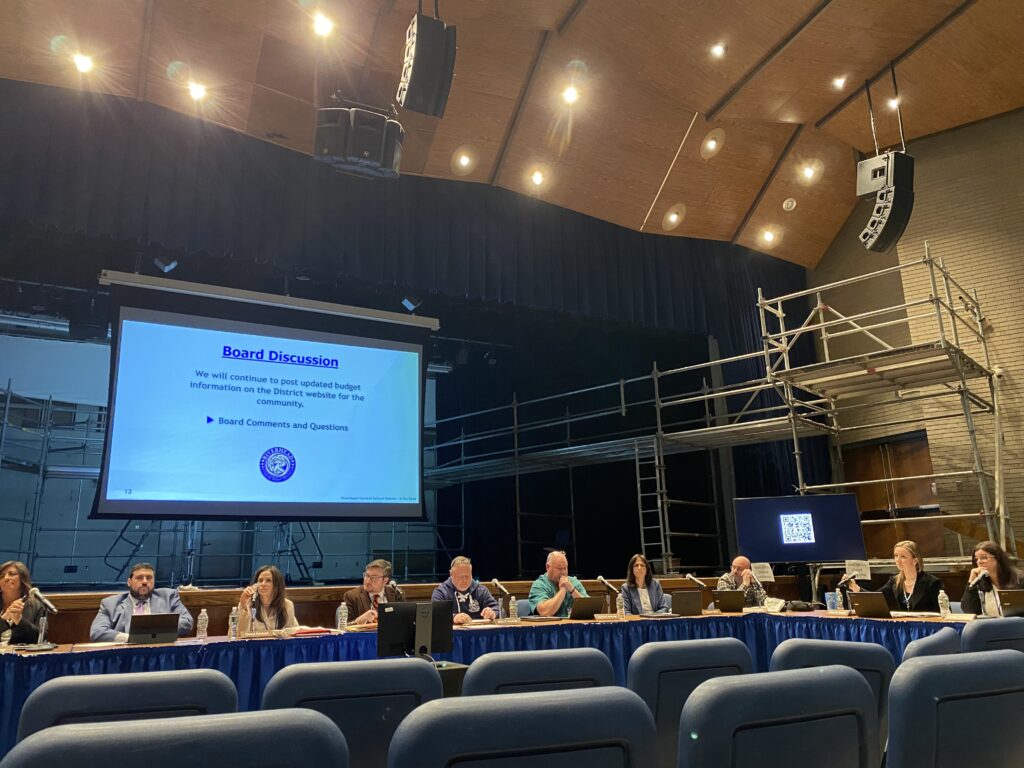Seeing the lights
The day started out with claps of thunder, gray skies and severe storm warnings, which might have discouraged a less determined crowd. But about 15 members of the East End Lighthouses organization and their 104 guests were undaunted on Saturday, June 5. By the time they embarked from Orient Point on Cross Sound Ferry’s Caribbean for a more than seven-hour tour of 10 lighthouses in Southold, New London, Conn., and Westerly, R.I., they were rewarded with mostly sunny skies, though there were some choppy waters and some clouds around Race Rock off Fishers Island.
Southold has eight lighthouses, the most of any town in the United States, with seven of them — all but Horton’s Point — offshore. The tour took in Long Beach Bar, Orient Point, Plum Island, Little Gull, Race Rock, North Dumpling, Latimer Reef, Watch Hill in Rhode Island and the New London Ledge and Pequot lights in Connecticut. The cruise was a fundraiser for the organization.
Greenport’s Bob Allen, whose grandfather and great-grandfather were lighthouse keepers, provided anecdotal narration, including his own memories of growing up around the lighthouses.
LONG BEACH BAR ‘BUG’ LIGHT
Mr. Allen’s great-grandfather was the keeper at Bug Light for some time, after transferring from Cedar Island Lighthouse outside Sag Harbor, where he’d spent 17 years. Located near Orient Beach State Park, at the eastern entryway to Greenport Harbor, Bug Light is the first lighthouse Cross Sound Ferry passengers see after the boats back away from the Orient dock en route to New London. Built in 1870, it was burned down by vandals on July 4, 1963. Only the foundation stood for years until the lighthouse was reconstructed on the site in 1990.
It came to be called Bug Light many years ago because at certain tides its exposed support structure made it look like a giant water bug. Mr. Allen’s great-grandmother, who always regretted leaving Cedar Island, had to get to their quarters at Bug Light by sliding up the rocks on her rear end.
On the morning in 1870 when wood for its construction was carried out to the site, Mr. Allen reports that a fisherman who had departed Southold in the early morning, passing the empty foundation, returned at night to see a standing lighthouse.
“To this day we don’t know if he quit drinking or started drinking that day,” Mr. Allen said.
During the hurricane of 1938, Mr. Allen’s great-grandfather and father were on the second floor at Bug Light and reported waves so high that they put out the light atop the building, 54 feet above sea level.
PLUM ISLAND LIGHT
Due to its animal disease laboratory, Plum Island has received a lot of attention from conspiracy theorists and novelists through the years, The lighthouse itself, on the western end of the island, is said to be haunted by a worker from nearby Gardiners Island, who contracted malaria, died and was buried on Plum Island long ago.
“He doesn’t like it,” Bob Allen said.
The beach in front of the lighthouse, established in 1827 and rebuilt around 1870, is armored by rocks that were blasted from Manhattan when the subway system was created. The rocks were first taken to Sag Harbor to reinforce the breakwater there. Eventually 15,000 tons of rocks were carried to Plum Island to provide erosion control.
There’s currently no functional light atop the Plum Island lighthouse. East End Lighthouses would like to take it over before the U.S. government decommissions the animal disease lab and, if all goes according to its plan, sells the island. The organization wants to see the light restored and enteredinto the National Register of Historic Places, according to the organization’s vice president, Peter Young of Mattituck, who was aboard for the cruise.
RACE ROCK
The Race off the western tip of Fishers Island is considered one of the most dangerous waterways on the East Coast and those aboard the Caribbean on June 5 got a taste of that as the boat hit rough, conflicting currents that rolled it from side to side. Sunny skies that had travelers in short sleeves just before coming into the Race found them donning jackets and coats under darkening skies as the passengers tried to hold on to railings for support.
Mr. Allen told the passengers that anyone who fell overboard would be carried rapidly out to sea. Given the many shipwrecks that occurred in the area — including the steamer Atlantic, on which 45 died in November 1846 — Race Rock Lighthouse was critical to safe navigation, he said. It was not established until 1878 and took seven years to construct. Thomas Albertson Scott, one of the project’s engineers, is also credited with building the foundation for the Statue of Liberty and the seawall at Governors Island.
Race Rock is also said to be haunted. Coast Guardsmen who have spent time there reported being pushed when no one was around and hearing water running in the shower when no one was bathing.
“If this lighthouse was on the market, I think I’d have to pass,” Mr. Allen said.
NORTH DUMPLING LIGHTHOUSE
Remember the Segway, the two-wheeled “green” transportation device that was supposed to change the way people travel? Its creator, Dean Kamen, always dreams big, according to Mr. Allen, which may explain what prompted Mr. Kamen to buy North Dumpling Lighthouse, off the north shore of Fishers Island, in 1986. Mr. Kamen declared the site a country unto itself and himself Lord Dumpling II, signed a nonaggression treaty with President George H.W. Bush and is said to operate his own navy there, comprising one amphibious vehicle.
North Dumpling was built in 1849 and rebuilt in 1871. The property around it changed hands several times, selling originally to the U.S. government in 1849 for $600. When Mr. Kamen acquired it, Mr. Allen said, he paid $2.5 million.
LATIMER REEF
North of the eastern tip of Fishers Island is Latimer Reef Light, known as a “coffee pot” lighthouse because of its shape; others have called it a spark plug, Mr. Allen said. It was named in memory of James Latimer, who spied on the British from its tiny, rocky site when they occupied Fishers Island during the Revolution. Mr. Latimer was eventually captured and hanged for his spying.
Built in 1884, the lighthouse was automated in 1974 and stands 55 feet high. Lighthouse keepers assigned to Latimer Reef all left the assignment with “big smiles on their faces” because they were so glad to get off what Mr. Allen called a “boring” island, which is why, though Latimer Reef Light is currently for sale, it’s another lighthouse Mr. Allen said he has no interest in buying.
WATCH HILL
Originally a four-acre site, the promontory on the Rhode Island coast where Watch Hill light stands has now shrunk to 2.4 acres due to beach erosion. Watch Hill got its name because it was a coastal lookout during the French and Indian War and the American Revolution. In 1806 President Thomas Jefferson signed a bill authorizing the building of a lighthouse on the site and the wooden structure that was erected there lasted until 1855. It was replaced by the existing granite lighthouse, which is 61 feet above sea level and still in good condition.
The resort community in the Watch Hill area was frequented by such luminaries as Clark Gable, Groucho Marx and Mary Pickford. Bob Allen tells the story that when Mr. Gable was told he couldn’t enter the lighthouse and climb to the top, he replied, “Frankly, I don’t give a damn.”
NEW LONDON LEDGE
New London residents don’t consider themselves ordinary people and they didn’t want a cheap lighthouse, Mr. Allen said. The distinctive colonial and Italianate red brick lighthouse was built in 1909 and stands 58 feet above sea level at the entrance to New London’s harbor.
It’s another allegedly haunted lighthouse, with the story of a keeper who committed suicide after learning that his wife had run off with a Block Island ferry captain. Although the keeper’s name was Jonathan, his ghost has been called Ernie and he reportedly can be seen peering out of lighthouse windows. Boats tied up at the dock have been untied and floated out to sea. Paranormal investigators report that Ernie is distraught about his wife’s betrayal but unwilling to leave New London Ledge, which has resulted in his being trapped between this life and the next, Mr. Allen said.
FUTURE EAST END LIGHTHOUSES TOURS
* Lighthouse and Maritime History Cruises aboard the Peconic Star II depart at 3:30 p.m. Saturday, June 26, July 17, Aug. 21 and Sept. 13.
* A members-only visit to Plum Island is slated for Monday, Aug. 9, at a time to be announced
For price information and reservations, call 406-6180 or visit eastendlighthouses.org.








